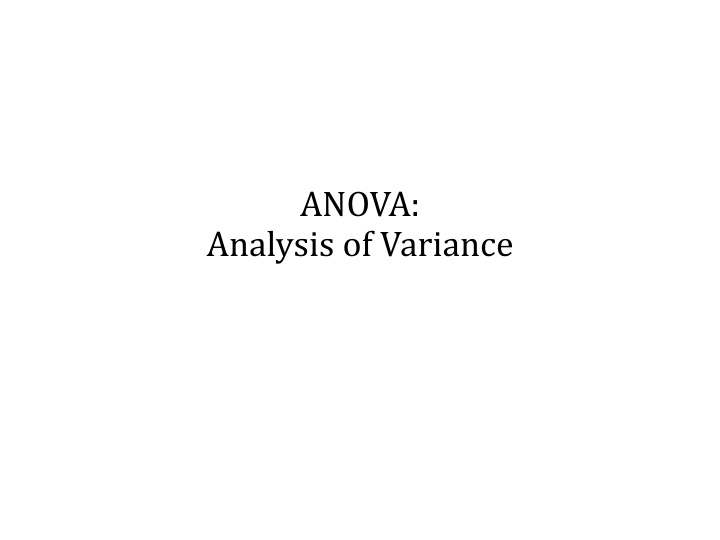



ANOVA: Analysis of Variance
An example ANOVA problem 25 individuals split into three between-subject conditions: A, B and C • A: 5,6,6,7,7,8,9,10 [8 participants, mean: 7.25] • B: 7,7,8,9,9,10,10,11 [8 participants, mean: 8.875] • P: 7,9,9,10,10,10,11,12,13 [9 participants, mean: 10.11] Are the differences between the conditions significant?
What does ANOVA do? ANOVA tests the following hypotheses: • 𝐼 " (null hypothesis): The means of all the groups are equal. • 𝐼 # : Not all the means are equal • doesn’t say how or which ones differ. • Can follow up with “multiple comparisons”
Notation for ANOVA • 𝑜 = number of individuals all together • 𝑗 = number of groups • 𝑦̅ = mean for entire data set is Group 𝑗 has • 𝑜 𝑗 = # of individuals in group i • 𝑦 𝑗𝑘 = value for individual j in group i • 𝑦 ) * = mean for group i • 𝑡 𝑗 = standard deviation for group i
How ANOVA works ANOVA measures two sources of variation in the data and compares their relative sizes • variation BETWEEN groups • for each data value look at the difference between its group mean and the overall mean * − 𝑦̅ - 𝑦 ) • variation WITHIN groups • for each data value we look at the difference between that value and the mean of its group - 𝑦 ). − 𝑦 ) *
F-score • The ANOVA F-statistic is a ratio of the Between Group Variaton divided by the Within Group Variation: 1234225 𝐺 = 6)37)5 • A large F is evidence against H 0 , since it indicates that there is more difference between groups than within groups.
ANOVA Output for Our Example Analysis of Variance summary Source DF SS MS F P Treatment 2 34.74 17.37 6.45 0.006 [between groups] Error 22 59.26 2.69 [within groups] Total 24 94.00
ANOVA Output for Our Example Analysis of Variance summary Source DF SS MS F P Treatment 2 34.74 17.37 6.45 0.006 [between groups] Error 22 59.26 2.69 [within groups] Total 24 94.00 # of data values - # of groups 1 less than # of (df for each group added together) groups 1 less than # of individuals
� � � � � � ANOVA Output for Our Example Analysis of Variance summary Source DF SS MS F P Treatment 2 34.74 17.37 6.45 0.006 [between groups] Error 22 59.26 2.69 [within groups] Total 24 94.00 - * − 𝑦̅ - 8 𝑦 ) 8 𝑦 ). − 𝑦 ) * - 8 𝑦 ). − 𝑦̅ SS =“sum of squares”
MSG = SSG / DFG MSE = SSE / DFE ANOVA Output for Our Example Analysis of Variance summary Source DF SS MS F P Treatment 2 34.74 17.37 6.45 0.006 [between groups] Error 22 59.26 2.69 [within groups] Total 24 94.00 34.74/2 = 17.37 P-value comes from F(DFG,DFE) F = MSG / MSE
Post-hoc analysis • ANOVA indicates that the groups do not all appear to have the same means… what next? How do we know what the differences really are? • If we only had two groups, then we’re done, we know the difference between them is significant. • If we have three or more groups, then a post hoc test is needed to determine which groups are significantly different from each other A: 5,6,6,7,7,8,9,10 [8 participants, mean: 7.25] B: 7,7,8,9,9,10,10,11 [8 participants, mean: 8.875] P: 7,9,9,10,10,10,11,12,13 [9 participants, mean: 10.11]
Post-hoc analysis • Multiple post hoc analysis methods exist • We most commonly see the Tukey test • Results for our example dataset: HSD[.05]=2.02; HSD[.01]=2.61 M1 vs M2 nonsignificant M1 vs M3 P<.01 M2 vs M3 nonsignificant HSD = the absolute (unsigned) difference between any two sample means required for significance at the designated level.
Assumptions of ANOVA • The distribution of data in each group is approximately normal • check this by looking at histograms and/or normal quantile plots • can handle some non-normality, but not severe outliers • Standard deviations of each group are approximately equal • rule of thumb: ratio of largest to smallest sample st. dev. must be less than 2:1
Our case study… • Our case study has many similarities to the above example, but in that case it’s a two-way ANOVA. I leave it to you to decide whether that is the appropriate test and what conclusions can be drawn from it based on the way it was conducted.
Recommend
More recommend